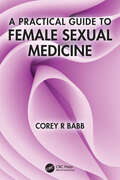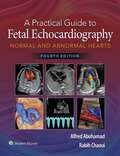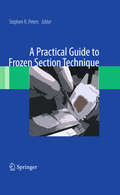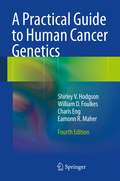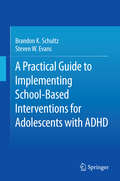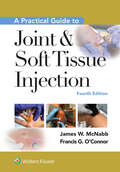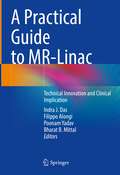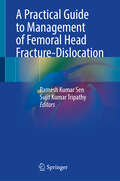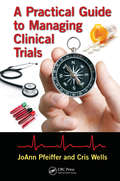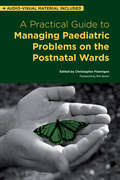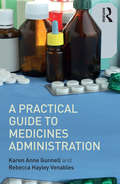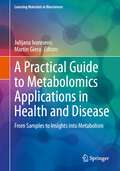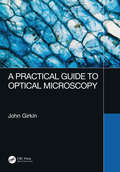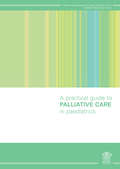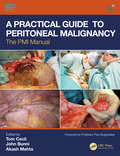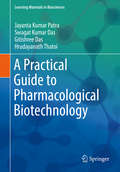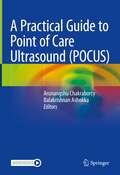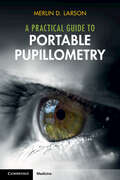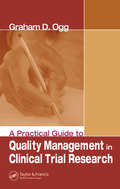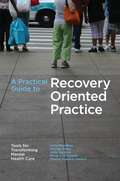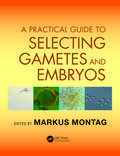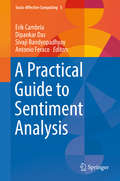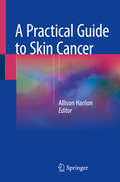- Table View
- List View
A Practical Guide to Drug Development in Academia: The SPARK Approach (SpringerBriefs in Pharmaceutical Science & Drug Development)
by Daria Mochly-Rosen Kevin Grimes"A lot of hard-won knowledge is laid out here in a brief but informative way. Every topic is well referenced, with citations from both the primary literature and relevant resources from the internet. " Review from Nature Chemical Biology Written by the founders of the SPARK program at Stanford University, this book is a practical guide designed for professors, students and clinicians at academic research institutions who are interested in learning more about the drug development process and how to help their discoveries become the novel drugs of the future. Often many potentially transformative basic science discoveries are not pursued because they are deemed 'too early' to attract industry interest. There are simple, relatively cost-effective things that academic researchers can do to advance their findings to the point that they can be tested in the clinic or attract more industry interest. Each chapter broadly discusses an important topic in drug development, from preclinical work in assay design through clinical trial design, regulatory issues and marketing assessments. After the practical overview provided here, the reader is encouraged to consult more detailed texts on specific topics of interest. "I would actually welcome it if this book's intended audience were broadened even more. Younger scientists starting out in the drug industry would benefit from reading it and getting some early exposure to parts of the process that they'll eventually have to understand. Journalists covering the industry (especially the small startup companies) will find this book a good reality check for many an over-hopeful press release. Even advanced investors who might want to know what really happens in the labs will find information here that might otherwise be difficult to track down in such a concentrated form. "
A Practical Guide to Female Sexual Medicine
by Corey R BabbThe appropriate diagnosis, management, and even terminology for women with sexual health problems have all been much debated in the past few years. This practical text aims to guide the gynecologists, urologists, family physicians, and other professionals involved with the care of these patients. With case presentations, treatment algorithms, and schematic illustrations, this comprehensive yet accessible text will be an invaluable reference for the current state of the clinical art. Provides an accessible guide to a very contested area of patient care Offers a comprehensive resource for the gynecologists, urologists, and family physicians involved in care for patients with female sexual dysfunction Presents a concise and practical route through the clinical details a professional physician needs for patient diagnosis and management
A Practical Guide to Fetal Echocardiography: Normal and Abnormal Hearts
by Rabih Chaoui Alfred AbuhamadCovering every aspect of fetal heart examination and all major cardiac malformations, A Practical Guide to Fetal Echocardiography is widely acknowledged as the definitive text in this challenging field. This award-winning title clearly depicts examples of commonly seen abnormalities and day-to-day cases, as well as rare pathology. Authored by renowned experts, the fully updated fourth edition is a lavishly illustrated, easy-to-read text designed to serve as a comprehensive reference for all practitioners involved in cardiac imaging.
A Practical Guide to Frozen Section Technique
by Stephen R. PetersA Practical Guide to Frozen Section Technique offers an easy to learn approach to frozen section technique in the form of a highly illustrated handbook intended for onsite use in the laboratory. The book begins with a novel, clearly delineated, step by step approach to learning continuous motion brush technique. Emphasis is placed on recognizing and correcting artifacts during the preparation process. The book addresses all of the steps in the preparation of slides from cutting through cover-slipping. The author's unique, original techniques for tissue embedding including face down embedding in steel well bars, frozen block cryoembedding and paper cryoembedding are detailed. Variables key to the quality of the preparation including block temperature, tissue properties and section thickness are detailed. The book also covers understanding the cryostat and basic maintenance and care.Sections covering techniques used in Mohs dermatologic surgery, and techniques used in basic animal and human research are discussed by noted experts in their field. A Practical Guide to Frozen Section Technique will be of great value to pathologists, pathology residents in training and also experimental pathology researchers that rely upon this methodology to perform tissue analysis in research.
A Practical Guide to Human Cancer Genetics
by William D. Foulkes Shirley V. Hodgson Charis Eng Eamonn R. MaherThis is a comprehensive and up-to-date guide to the diagnosis, clinical features and management of inherited disorders conferring cancer susceptibility. It is fully updated with much molecular, screening and management information. It covers risk analysis and genetic counselling for individuals with a family history of cancer. It also discusses predictive testing and the organisation of the cancer genetics service. There is information about the genes causing Mendelian cancer predisposing conditions and their mechanism of action. It aims to provide such details in a practical format for geneticists and clinicians in all disciplines.
A Practical Guide to Implementing School-Based Interventions for Adolescents with ADHD
by Brandon K. Schultz Steven W. EvansThis innovative volume details counseling interventions for secondary students with ADHD and its associated academic and conduct problems, particularly focusing on youth at risk for developing serious disruptive behaviors. It addresses the continuing debate over counseling for youths with ADHD by identifying key elements common to reputable therapies and suggesting a framework for their successful implementation. The core of the book discusses the Challenging Horizons Program (CHP), a behavior- and solutions-focused approach to counseling adolescents with ADHD that has been studied extensively for more than 15 years. Based on the quality of research, the CHP has been included in the National Registry of Evidence-based Programs and Practices maintained by the U. S. Substance Abuse and Mental Health Services Administration (SAMHSA). Excerpts from actual sessions illustrate typical therapist-client interactions in the CHP, and sample modules from the program's treatment literature expand the book's descriptions of effective hands-on interventions. Counseling skills featured in this book include: Bridging the research-into-practice divide. Establishing a therapeutic alliance with students with ADHD. Developing and implementing interventions for memory, organization, and planning. Enhancing young clients' social skills. Enlisting family members in the intervention process. Working directly with teachers to improve student behaviors. A Practical Guide to Implementing School-Based Interventions for Adolescents with ADHD is an essential resource for researchers, clinicians and related professionals, and graduate students in such disciplines as school and clinical child psychology, social work, educational psychology, psychotherapy and counseling, and learning and instruction.
A Practical Guide to Joint & Soft Tissue Injection
by Francis O'Connor James McNabbFeaturing highly illustrated, evidence-based information along with high-quality videos, A Practical Guide to Joint & Soft Tissue Injection is the definitive guide to effective injection procedures that can be performed with simple equipment in a variety of settings. Expanded and updated for the fourth edition, this practical, award-winning guide thoroughly explains the rationale and step-by-step technique for each procedure, helping you offer patients immediate relief from pain and discomfort.
A Practical Guide to MR-Linac: Technical Innovation and Clinical Implication
by Indra J. Das Bharat B. Mittal Filippo Alongi Poonam YadavThis book offers a detailed guide to MR-Linac, a unique and fast growing radiation treatment modality. MR-linac is new technology that is a fusion of an MRI and a linear accelerator on the same gantry. It can change both target volume delineation and tumor visualization in real time using MR-cine images and treatment. Tumor location changes moment to moment as radiation is delivered, but this cannot be visualized in current radiation therapy practices. This new and rapidly growing technology can provide adaptive therapy that was not possible before. This book presents current knowledge on MR-linac technology, clinical practices, and ultimately patient outcome where dose escalation is not possible due to limiting normal tissue structures in the vicinity of tumor. There are two commercial MR-linac machines under consideration and both will be covered in detail. The book is divided into four sections. The first gives a general introduction to MR-Linac, covering the role of MRI inradiation oncology, the clinical necessity of this technology, and patient selection. The next section details the physics and technology of MR-Linac, covering image sequence, motion management, and treatment planning. Section three offers the clinical applications of MR-Linac and is divided by body area, including lung, prostate, and breast. Finally, the fourth section looks to the future and what this technology can mean for radiation oncology. This is an ideal guide for radiation oncologists, medical physicists, and relevant trainees.
A Practical Guide to Management of Femoral Head Fracture-Dislocation
by Ramesh Kumar Sen Sujit Kumar TripathyThe book is a comprehensive resource on the complex and challenging condition of Pipkin fracture-dislocation. It provides a detailed exploration of the anatomy, diagnosis, and management of Pipkin fractures, offering essential insights and practical guidance for both experienced orthopedic surgeons and novice medical professionals. Integrating case studies and real-world examples, the book illustrates key concepts and outcomes, ensuring a thorough understanding of both theoretical and practical aspects. The book begins with a thorough overview of the involved anatomical structures, followed by an examination of injury mechanisms and classification systems, structured for ease of learning and application. Each chapter meticulously addresses various diagnostic techniques, including advanced imaging modalities, and details both conservative and surgical treatment options. Written by leading orthopedic experts, it presents a balanced perspective on contemporary treatment protocols and highlights the latest advancements in surgical techniques and post-operative care. Illustrated with high-quality images and diagrams, the book is an invaluable reference for clinicians aiming to enhance their knowledge and expertise in managing this complex injury. It targets orthopedic surgeons, trauma specialists, and medical students.
A Practical Guide to Managing Clinical Trials
by JoAnn Pfeiffer Cris WellsA Practical Guide to Managing Clinical Trials is a basic, comprehensive guide to conducting clinical trials. Designed for individuals working in research site operations, this user-friendly reference guides the reader through each step of the clinical trial process from site selection, to site set-up, subject recruitment, study visits, and to study close-out. Topics include staff roles/responsibilities/training, budget and contract review and management, subject study visits, data and document management, event reporting, research ethics, audits and inspections, consent processes, IRB, FDA regulations, and good clinical practices. Each chapter concludes with a review of key points and knowledge application. <P><P> Unique to this book is "A View from India," a chapter-by-chapter comparison of clinical trial practices in India versus the U.S. Throughout the book and in Chapter 10, readers will glimpse some of the challenges and opportunities in the emerging and growing market of Indian clinical trials.
A Practical Guide to Managing Paediatric Problems on the Postnatal Wards
by Christopher FlanniganDoctors, midwives and other professionals entering the field of postnatal care frequently feel ill-prepared for the task, and a lack of accessible and relevant learning resources can leave learning on the job as the only realistic option. This combined book and DVD resource has been specifically created to provide an accessible guide to the clinical problems those new to postnatal care will face: what to do, how to counsel parents, and how to manage the most common scenarios. Demystifying the transition into the field, it provides practical solutions, and access to relevant background information through extensive references. The accompanying DVD explores specific areas though audiovisual presentations, including jaundice, hypoglycaemia, common issues in newborn examinations and neonatal management of antenatally-detected renal tract dilation. Created by experienced consultant neonatologists and senior trainees who deal regularly with the recurrent themes of day-to-day newborn care, this groundbreaking resource will be essential reading and viewing for all doctors, midwives, nurses and other health professionals new to the field.
A Practical Guide to Medicine Administration
by Rebecca Hayley Venables Karen Anne GunnellIt is important that medicines are administered correctly, in order to provide correct drug doses, yet not all healthcare professionals are expert in the area. This accessible book provides a definitive guide to best practice in administering medicinal formulations. Acting as a quick reference handbook for administration techniques in both the simulated and real practice environment, the book enables readers to advise patients on the correct use of their formulation. It covers the following formulation types: oral topical ocular aural nasal inhaled transdermal patches vaginal rectal. A Practical Guide to Medicines Administration is a key resource for both student and practising pharmacists who counsel and advise patients on the use of their medicines. It will also be a useful reference for nurses, nursing associates, assistant practitioners and healthcare assistants.
A Practical Guide to Metabolomics Applications in Health and Disease: From Samples to Insights into Metabolism (Learning Materials in Biosciences)
by Martin Giera Julijana IvanisevicThis well-accessible textbook constitutes a practical guide to metabolomics approaches and applications in an integrative manner. Illustrated by numerous real-life examples and case studies the book teaches how to set up and carry out metabolomics experiments, from sample collection to storage techniques, and guides the reader through the potentials and challenges of metabolite analysis. In addition, this textbook shows how to obtain insights into molecular mechanisms deployed in different physiological contexts (e.g., exercise, healthy ageing) as well as in different (metabolic) diseases, be it Diabetes, Cancer, Alzheimer´s Disease, Asthma or others. The book brings together knowledge from biochemical, biological, and medical aspects, and further equips the reader with know-how from sample collection and handling to data processing, analysis and interpretation. This textbook is a must-have for advanced undergraduates and graduate students interested in applied biochemistry and metabolomics, as well as for instructors who teach courses in biomedicine, physiology or biochemistry.
A Practical Guide to Optical Microscopy
by John GirkinOptical microscopy is used in a vast range of applications ranging from materials engineering to in vivo observations and clinical diagnosis, and thanks to the latest advances in technology, there has been a rapid growth in the number of methods available. This book is aimed at providing users with a practical guide to help them select, and then use, the most suitable method for their application. It explores the principles behind the different forms of optical microscopy, without the use of complex maths, to provide an understanding to help the reader utilise a specific method and then interpret the results. Detailed physics is provided in boxed sections, which can be bypassed by the non-specialist. It is an invaluable tool for use within research groups and laboratories in the life and physical sciences, acting as a first source for practical information to guide less experienced users (or those new to a particular methodology) on the range of techniques available. Features: The first book to cover all current optical microscopy methods for practical applications Written to be understood by a non-optical expert with inserts to provide the physical science background Brings together conventional widefield and confocal microscopy, with advanced non-linear and super resolution methods, in one book
A Practical Guide to Palliative Care in Paediatrics
by Children’s Health Queensland Hospital and Health Service – Paediatric Palliative Care Service Queensland Government Australian and New Zealand Paediatric Palliative Care Reference GroupThis ebook is a practical guide to all of the issues relating to the care of a child or young person with a life limiting condition. It aims to empower clinicians to care for children at home or as close to home as possible. It is a national resource and a major contribution towards supporting dying children and their families to have the best quality of life. Sections include psychosocial considerations, symptom management, the dying process, bereavement and ethics. New sections for this edition include perinatal palliative care and quality improvement in paediatric palliative care. The booklet includes a number of appendices including commonly used drugs and doses. The booklet where possible tries to be evidence based, and reflects best practice guidelines for the Australian and New Zealand context.
A Practical Guide to Palliative Care in Paediatrics: Paediatric Palliative Care for Health Professionals
by No-surname Children’s Health Queensland Hospital and Health Service – Paediatric Palliative Care Service No-surname Australian and New Zealand Paediatric Palliative Care Reference Group No-surname Queensland GovernmentThis ebook is a practical guide to all of the issues relating to the care of a child or young person with a life limiting condition. It aims to empower clinicians to care for children at home or as close to home as possible. It is a national resource and a major contribution towards supporting dying children and their families to have the best quality of life. Sections include psychosocial considerations, symptom management, the dying process, bereavement and ethics. New sections for this edition include perinatal palliative care and quality improvement in paediatric palliative care. The booklet includes a number of appendices including commonly used drugs and doses. The booklet where possible tries to be evidence based, and reflects best practice guidelines for the Australian and New Zealand context.
A Practical Guide to Peritoneal Malignancy: The PMI Manual
by Tom Cecil, John Bunni and Akash MehtaPeritoneal malignancy is a rapidly growing field within surgical oncology. National and International treatment programmes and training curricula are being established worldwide to co-ordinate treatment and management of these challenging clinical problems. A large body of evidence now exists, but the practical implications of this evidence base remain unclear. The Peritoneal Malignancy Institute in Basingstoke, the largest centre in the world, is at the forefront of new developments and techniques. This manual combines the experience of the PMI with the latest evidence to provide a practice-oriented guide to the successful set up and running of a peritoneal malignancy unit.
A Practical Guide to Pharmacological Biotechnology (Learning Materials in Biosciences)
by Jayanta Kumar Patra Gitishree Das Swagat Kumar Das Hrudayanath ThatoiPharmacological biotechnology is applied to and used to study drug development, working mechanisms, diagnosis, and therapies. This textbook covers the whole range of experiments related to pharmacology. It also contains basic laboratory safety guidelines along with the basic calculations and formulas used in a laboratory. Each chapter starts with an introduction/theory into the basic approach followed by detailed methods sections with easy-to-follow protocols and comprehensive troubleshooting, calculations and possible questions for examination. The target group is researchers who are studying pharmacological biotechnology in the laboratory.
A Practical Guide to Point of Care Ultrasound (POCUS)
by Arunangshu Chakraborty Balakrishnan AshokkaThis book covers point of care ultrasound (POCUS) in a practical, problem oriented and illustrated manner. It begins with introduction to the basic principles of medical ultrasound imaging and ultrasound guided interventions and outlines point of care ultrasound in a lucid manner for rapid learning for medical students as well as practitioners. It contains chapters on ultrasound of the airways, thoracic ultrasound including lungs and transthoracic screening echocardiogram, vascular assessment, ultrasound of the abdomen for focussed trauma assessment, gastric volume assessment and ultrasound guided interventions such as vascular cannulations, pleurocentesis, etc. along with some of the latest point of care ultrasound techniques such as ocular assessment and assessment of the foetus and placenta in the operation theatre. This book will help the intensivist, emergency physician and anaesthesiologist to learn the basics of POCUS, which ostensibly, is the future of medical practice. It also includes objective structured clinical examination (OSCE) questions after every chapter as well as multiple choice questions (MCQs) that will benefit the students greatly. The book also includes videos from some of the celebrated practitioners of POCUS providing a unique learning experience. This book is suited for students, trainees and practitioners alike. The modules of POCUS described here are part of the curriculum of anaesthesiology in the UK, USA, Singapore, Australia/ New Zealand and most of the countries. The book also covers the curriculum of POCUS in critical care and emergency medicine courses.
A Practical Guide to Portable Pupillometry
by Merlin D. LarsonThe applications and advantages of portable pupillometry for a wide variety of healthcare providers are becoming increasingly evident, with frequent pupil evaluation becoming the protocol throughout critical care and emergency departments. Authored by a world leading expert, this practical, user-friendly book brings together all the research on portable pupillometry and explains the meaning of the various parameters that new portable pupillometers provide. Starting with the anatomy and physiology of the pupil, the book moves on to discuss pharmacological effects, unusual pupillary syndromes, measurement and size of the pupil, pupillary reflex dilation and pupillary unrest. Additional chapters focus on traumatic brain injury, cardiac arrest, intensive care, opioid effect, acute pain and anisocoria and provide valuable clinical examples and case reports. Also featuring an extensive bibliography for further reading, this book is essential reading for all healthcare professionals using the pupil to evaluate drug effects and ischemic/traumatic insults to the brain.
A Practical Guide to Quality Management in Clinical Trial Research
by Graham OggSetting up a GXP environment where none existed previously is a very daunting task. Getting staff to write down what they do for every task is a correspondingly difficult and time-consuming exercise. Examining how to maintain quality control in clinical trial research, A Practical Guide to Quality Management in Clinical Trial Research provides a co
A Practical Guide to Recovery-Oriented Practice: Tools for Transforming Mental Health Care
by Janis Tondora Larry Davidson Michael Rowe Maria J. O'Connell Martha Staeheli LawlessThis book takes a lofty vision of "recovery" and of "a life in the community" for every adult with a serious mental illness promised by the U. S. President's 2003 New Freedom Commission on Mental Health and shows the reader what is entailed in making this vision a reality. Beginning with thehistorical context of the recovery movement and its recent emergence on the center stage of mental health policy around the world, the authors then clarify various definitions of mental health recovery and address the most common misconceptiosn of recovery held by skeptical practitioners and wroriedfamilies. With this framework in place, the authors suggest fundamental principles for recovery-oreinted care, a set of concrete practice guidelines developed in and for the field, a recovery guide model of practice as an alternative to clinical case management, and tools to self-assess therecovery orientation of practices and practitioners. In doing so, this volume represents the first book to go beyond the rhetoric of recovery to its implementation in everyday practice. Much of this work was developed with the State of Connecticut's Department of Mental Health and Addiction Services, helping the state to win a #1 ranking in the recent NAMI report card on state mental health authorities. Since initial development of these principles, guidelines, and tools inConnecticut, the authors have become increasingly involved in refining and tailoring this approach for other systems of care around the globe as more and more governments, ministry leaders, system managers, practitioners, and people with serious mental illnesses nad their families embrace the needto transform mental health services to promote recovery and community inclusion. If you've wondered what all of the recent to-do has been about with the notion of "recovery" in mental health, this book explains it. In addition, it gives you an insider's view of the challenges and strategies involved in transforming to recovery and a road map to follow on the first few stepsdown this exciting, promising, and perhaps long overdue path.
A Practical Guide to Selecting Gametes and Embryos
by Markus MontagAmong the many recent advances in assisted reproduction therapies (ART), improved technologies for identifying viable oocytes, sperm, and embryos are of primary importance. Paradoxically, the latest advances presented at conferences and symposia are often slow to become part of the daily routine in IVF laboratories. Detailing established and develo
A Practical Guide to Sentiment Analysis (Socio-Affective Computing #5)
by Erik Cambria Dipankar Das Sivaji Bandyopadhyay Antonio FeracoSentiment analysis research has been started long back and recently it is one of the demanding research topics. Research activities on Sentiment Analysis in natural language texts and other media are gaining ground with full swing. But, till date, no concise set of factors has been yet defined that really affects how writers' sentiment i. e. , broadly human sentiment is expressed, perceived, recognized, processed, and interpreted in natural languages. The existing reported solutions or the available systems are still far from perfect or fail to meet the satisfaction level of the end users. The reasons may be that there are dozens of conceptual rules that govern sentiment and even there are possibly unlimited clues that can convey these concepts from realization to practical implementation. Therefore, the main aim of this book is to provide a feasible research platform to our ambitious researchers towards developing the practical solutions that will be indeed beneficial for our society, business and future researches as well.
A Practical Guide to Skin Cancer
by Allison HanlonSkin cancer is the most common malignant neoplasm, and with the increasing regularity of such tumors comes the need for a practical guide for medical professionals to reference for diagnosis, management, and treatment. This book covers everything from the epidemiology of the skin cancer, clinical presentation with clinical photographs, diagrams of the most common anatomical locations, to histological descriptions, special stains/tests for diagnosis, and a treatment algorithm in chart form. A Practical Guide to Skin Cancer offers brief and succinct chapters with pertinent references, as well as high quality color photographs, diagrams, tables, and charts. Written for dermatologists, dermatology residents, and oncologists, this book allows for the reader to quickly and easily obtain the information regarding a tumor’s clinical presentation, patient evaluation and treatment algorithms, proving essential for every physician who encounters these tumors in their daily practice.

